Mazesoba, often called Mazemen here in the US, is Japanese brothless ramen that originated in Nagoya. The thick, chewy noodles are mixed with well-seasoned minced pork, garlic chives, green onion, nori seaweed, katsuobushi powder, and sous vide egg yolk. The creamy texture and savory flavorings make this a satisfying treat.
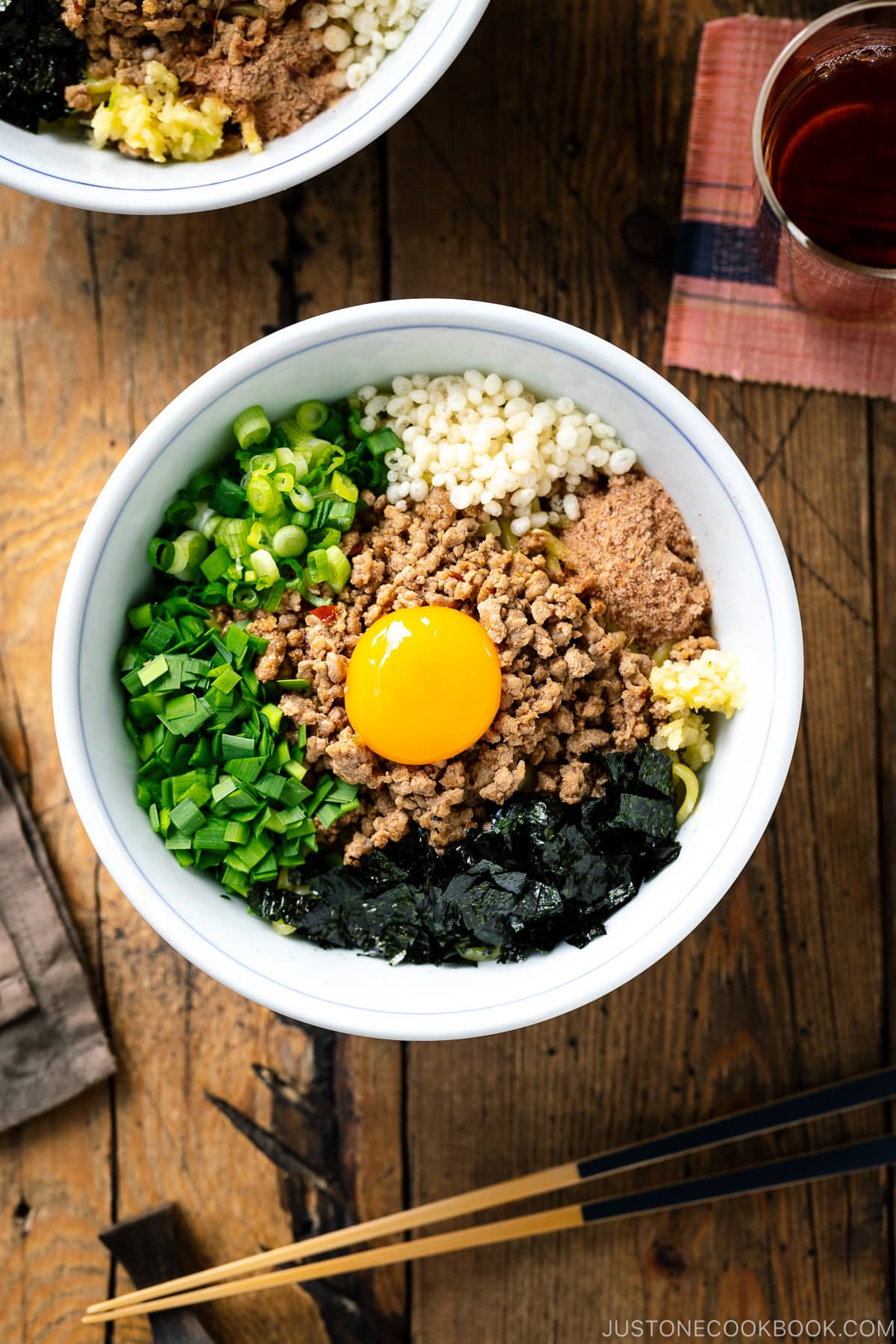
Mazesoba (まぜそば), a Japanese brothless ramen noodle, was one on our must-eat list when we visited Nagoya several years ago. Nagoya food or Nagoya meshi (名古屋めし) is unique to Nagoya and its surroundings in Aichi Prefecture and cannot be found anywhere else in Japan.
I’ve shared a few well-known Nagoya meshi such as Miso Katsu, Hitsumabushi (Unagi Chazuke), Nagoya-Style Fried Chicken Wings, and Ogura Toast on the blog. And today, I’m bringing you the popular mazesoba (or mazemen) recipe that can easily be made at home!
For those in the US, you might have tried mazesoba being served as one of the versions of mazemen (まぜ麺). As more authentic ramen joints started to offer mazemen on their menus, this soup-less style ramen is becoming a mainstream style of ramen. Just recently, I’ve also discovered that a broth-less ramen chain Kajiken is opening in my neighborhood and I’m looking forward to trying it out.
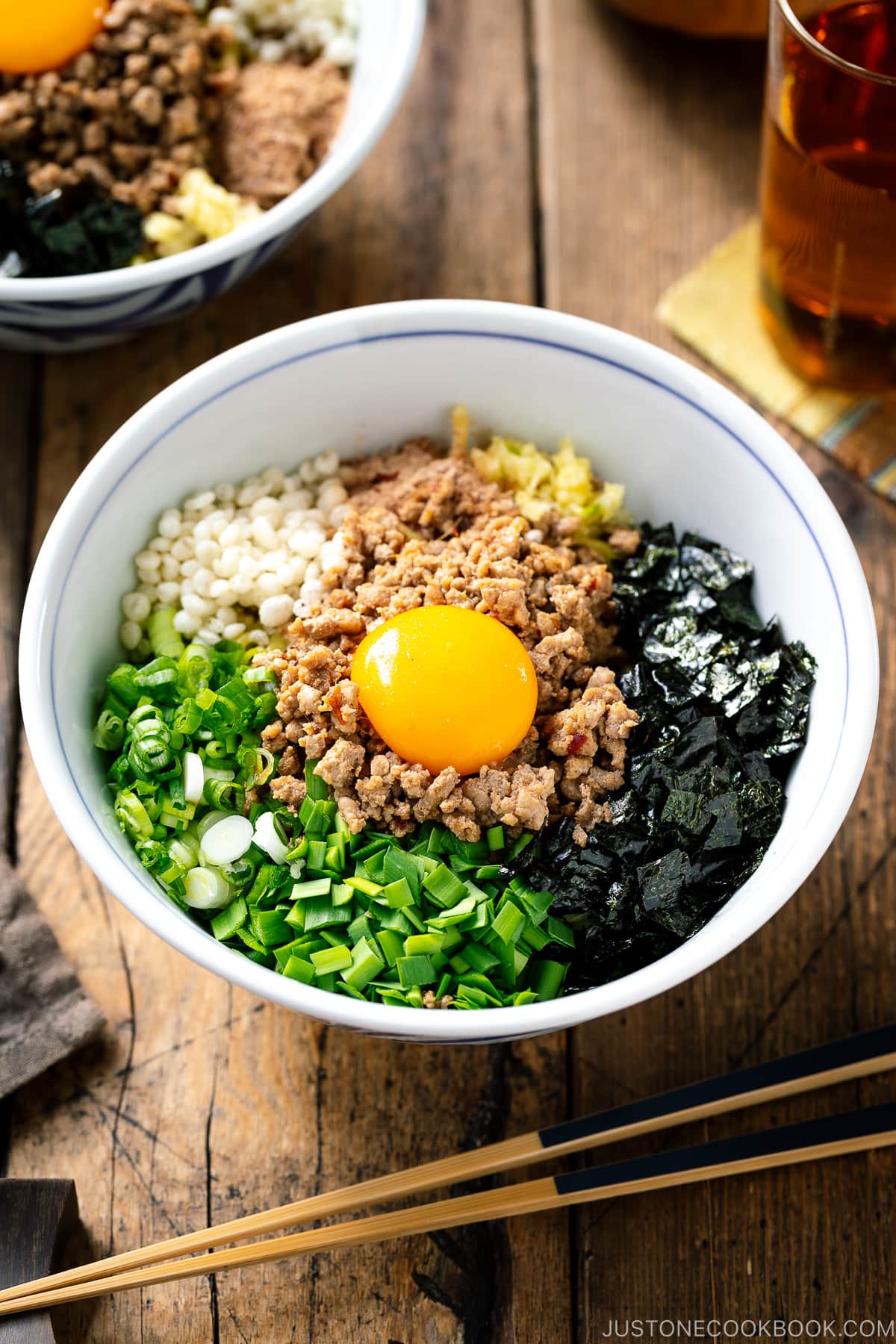
What is Mazesoba?
Mazesoba (まぜそば), or what we often call the Taiwan-style mazesoba (台湾まぜそば) or sometimes mazemen, translates to ‘mixed noodles’ in Japanese. It is a soup-less variety of ramen originated in Nagoya city.
This ramen is composed of thick chewy noodles, ground pork mixture, and a variety of toppings such as green onions, garlic chives, minced garlic, and egg yolk. This dry-style noodle doesn’t come with any broth, so the flavors rely heavily on the savory pork mixture and toppings.
Mazesoba came about in 2008 from a specialty noodle shop called Menya Hanabi (麺屋はなび). The owner wanted to make Taiwan ramen, a Nagoya specialty dish but he couldn’t achieve a good soup broth that was to his satisfaction. When he was about to throw away the minced meat, one of his part-time workers suggested serving it with boiled noodles. The cook improved the dish and that gave birth to the current “Taiwan mazesoba.”
The Difference between Mazesoba, Mazumen, and Abura Soba?
Oftentimes, when a specific dish is being transported outside of Japan, it’s very likely being renamed, loosely translated, or reinvented for various reasons.
In the US, mazemen (まぜ麺) has come to be the customary term for Japanese broth-less style ramen. I take it as a rebranding and that allows more room for chefs to come up with their own renditions. You’ll find all sorts of creative interpretations from uni mazemen, soft shell crab mazemen to mentaiko mazemen being offered at restaurants. They all share similar components: thick style noodles, tare (seasoning), sometimes seasoned oil, and toppings, but without the soup/broth.
On the other hand, you’ll also find abura soba (油そば), which is another popular broth-less ramen dish almost identical to mazesoba. They were originally the same dish, but both have evolved with slightly different characteristics. The main difference is how the noodles and sauce are combined.
In general, mazesoba is served with seasoned pork mixture and garnished with more toppings. Abura soba is usually served with a few slices of pork belly chashu with fewer toppings, and the sauce is placed underneath noodles so you have to mix them all up when you eat.
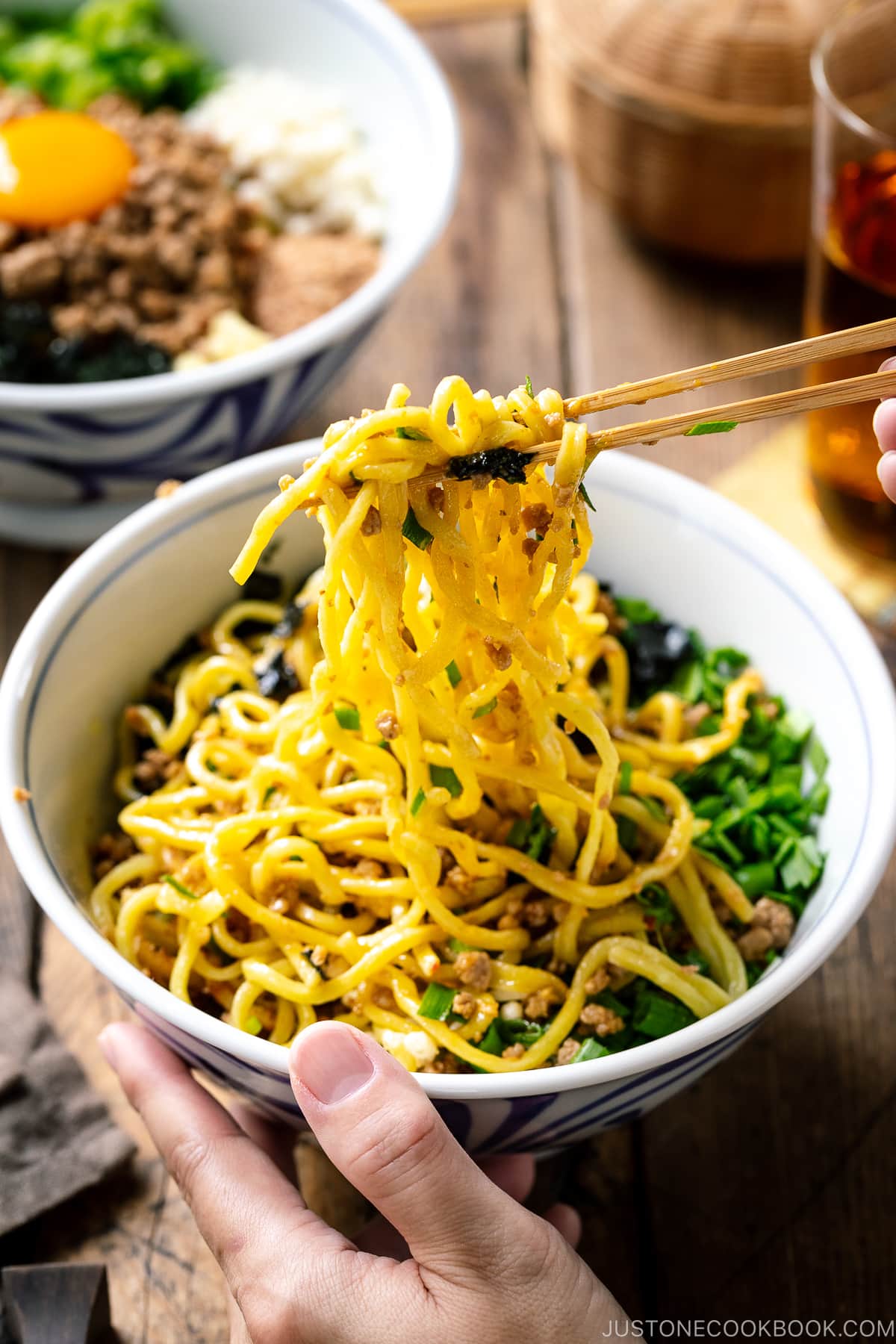
How to Make Mazesoba
Ingredients You’ll Need
- Ramen Noodles – I recommend getting thick ramen noodles. Sun Noodles in the US sell Mazemen noodle package that includes 2 packs of thick noodles.
- Ground pork
- Seasonings: sesame oil, doubanjiang (chili bean paste), soy sauce, oyster sauce, sugar, chicken stock, and salt
- Aromatics: garlic, ginger, green onions, Chinese chives
- Toppings: nori seaweed, katsuobushi (dried bonito flakes), tenkasu (tempura scraps), sous vide egg yolk
Use of raw egg (or sous-vide egg):
In Japan, it’s safe to consume raw eggs, but not in the U.S. You can get pasteurized eggs or sous vide eggs. Egg yolk in this recipe adds a nice creamy texture and adds richness in flavor. You can also use Onsen Tamago, Soft Boiled Egg, or poached egg.
Substitute for Vegan/Vegetarian:
You can swap the ground pork easily with meat alternatives (tofu, meat crumbles, etc). Use vegetarian stir fry sauce instead of oyster sauce and vegetable stock instead of chicken stock.
Please skip katsuobushi and sous-vide egg yolk.
Overview: Cooking Steps
- Prepare all the ingredients.
- Stir fry and season the ground pork.
- Cook the ramen noodles.
- Assemble the noodles and all the toppings.
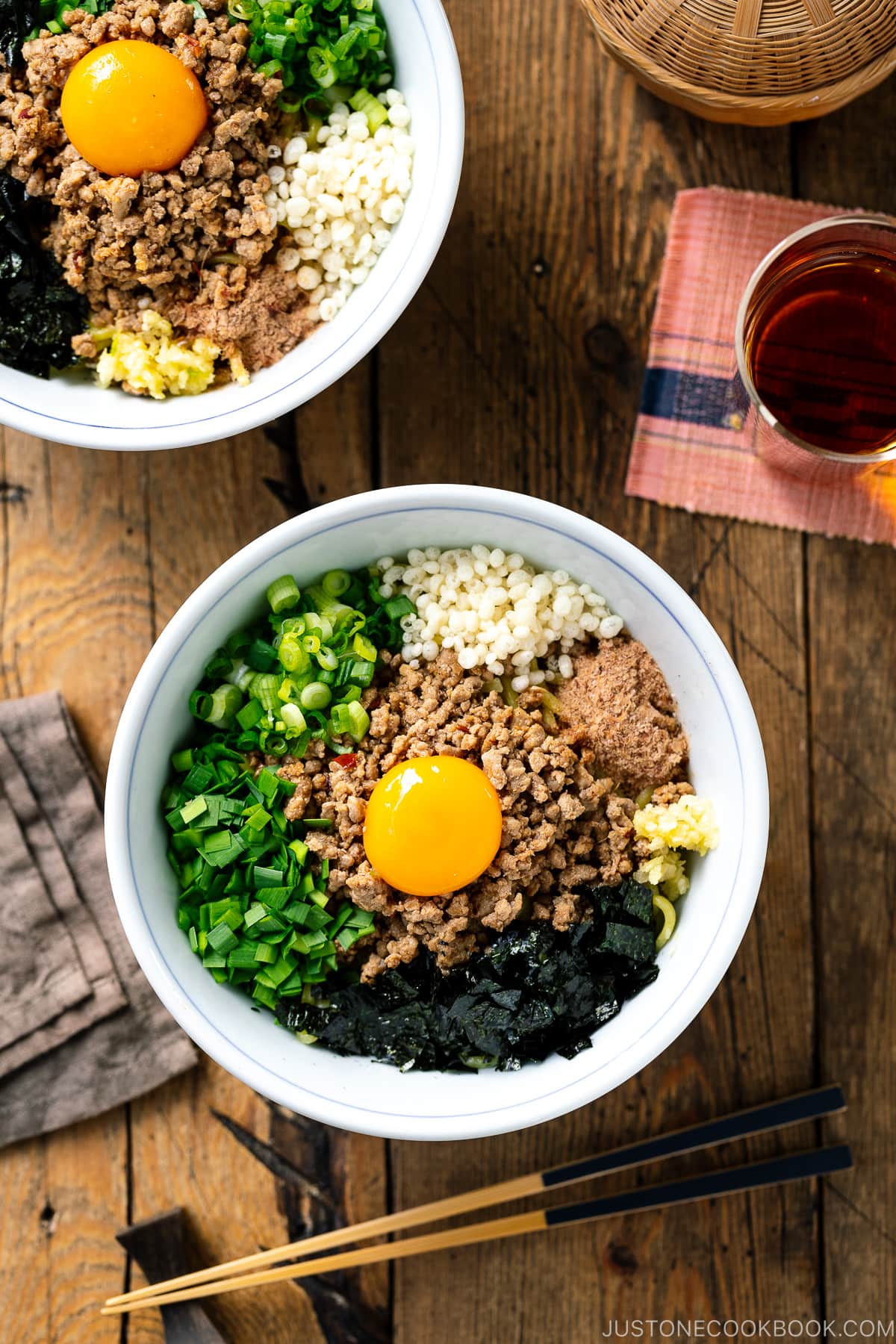
Mazesoba Cooking Tips
- Cut the toppings into the same size pieces. This is crucial for creating a specific presentation for the noodle dish and for easy mixing.
- Reserve the cooking liquid for the pork mixture. As you simmer the pork mixture, the cooking liquid will be reduced and flavors will be concentrated. However, you want to reserve some cooking liquid for the meat so the ground pork mixture has some fat and liquid to intertwine with the noodles.
- Serve the dish immediately while it’s warm. This is actually quite important! Since some of the toppings are at room temperature, the dish gets cool faster than the typical ramen with a broth. Once the noodles get cold and stick to each other, it’s very hard to mix it all up and the dish becomes less appetizing.
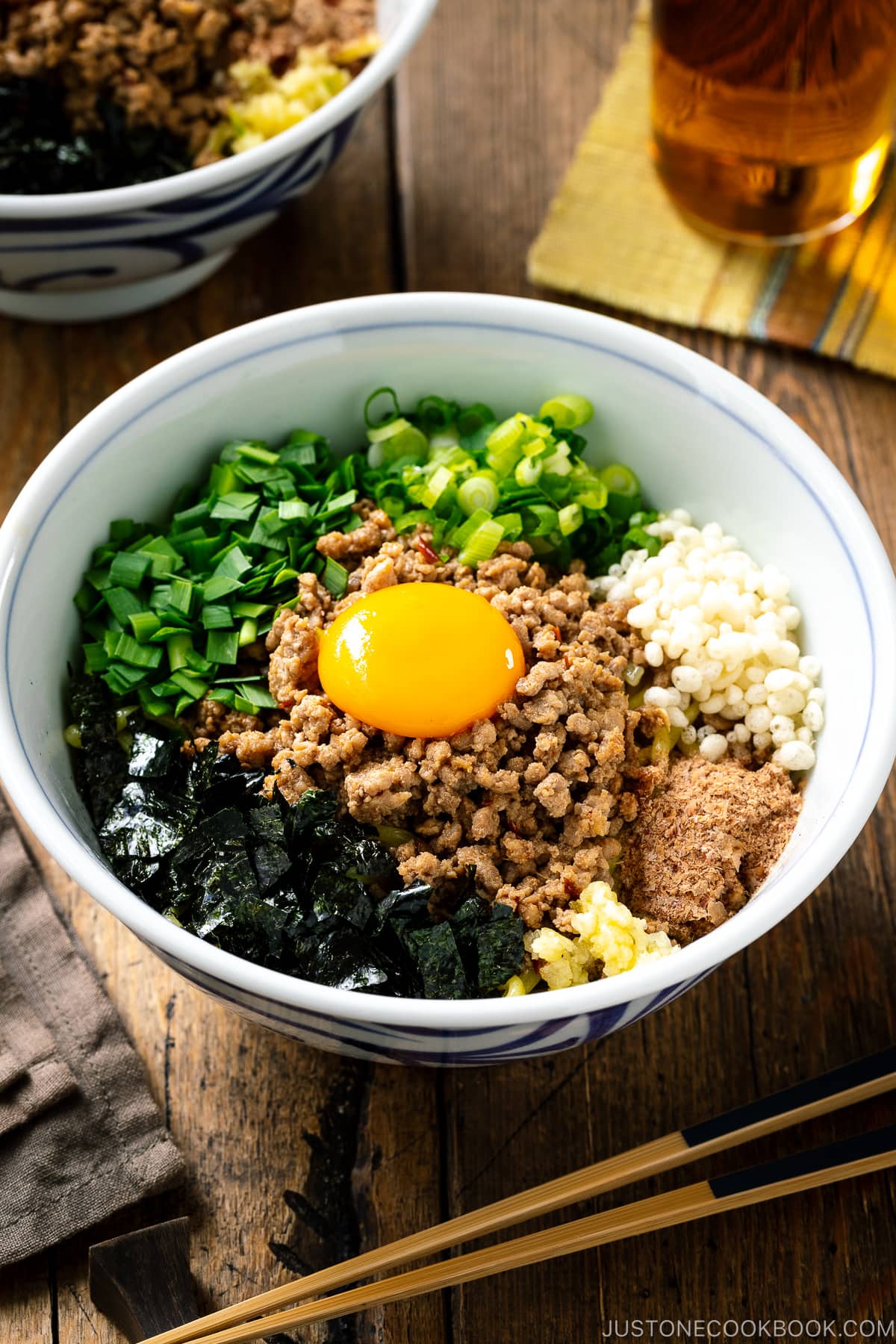
How to Enjoy Mazesoba
While it’s slightly warm, mix the noodles and toppings with chopsticks. It’s much easier to mix them up when both noodles and pork mixture are warm. Thick wavy noodles are specially used for this dish so that noodles cling well with the toppings.
Personally, I love adding more katsuobushi powder to my noodles than I specified in the recipe. Because the pork mixture itself is well seasoned, the katsuobushi powder would not be overpowering. Instead, it adds an umami depth to the dish.
When you finish eating the noodles, it’s possible that some seasoned minced pork is left in the bowl. In Japan, it’s very common to ask for an oi-meshi (追い飯), a bowl of steamed white rice. You can add the steamed rice to the leftover pork mixture and you mix them up to eat.
If you have extra seasoned pork, freeze the leftovers for later use. My kids love the rice ball made with this minced pork. I simply defrost the meat toppings and mix them with steamed rice. Then, make rice balls.
More Delicious Noodle Recipes
Tableware from Musubi Kiln
I’ve partnered with a great ceramic online shop from Japan called Musubi Kiln. You will get 10% off with a coupon code JUSTONECOOKBOOK for your purchase. In this post, I’ve used:
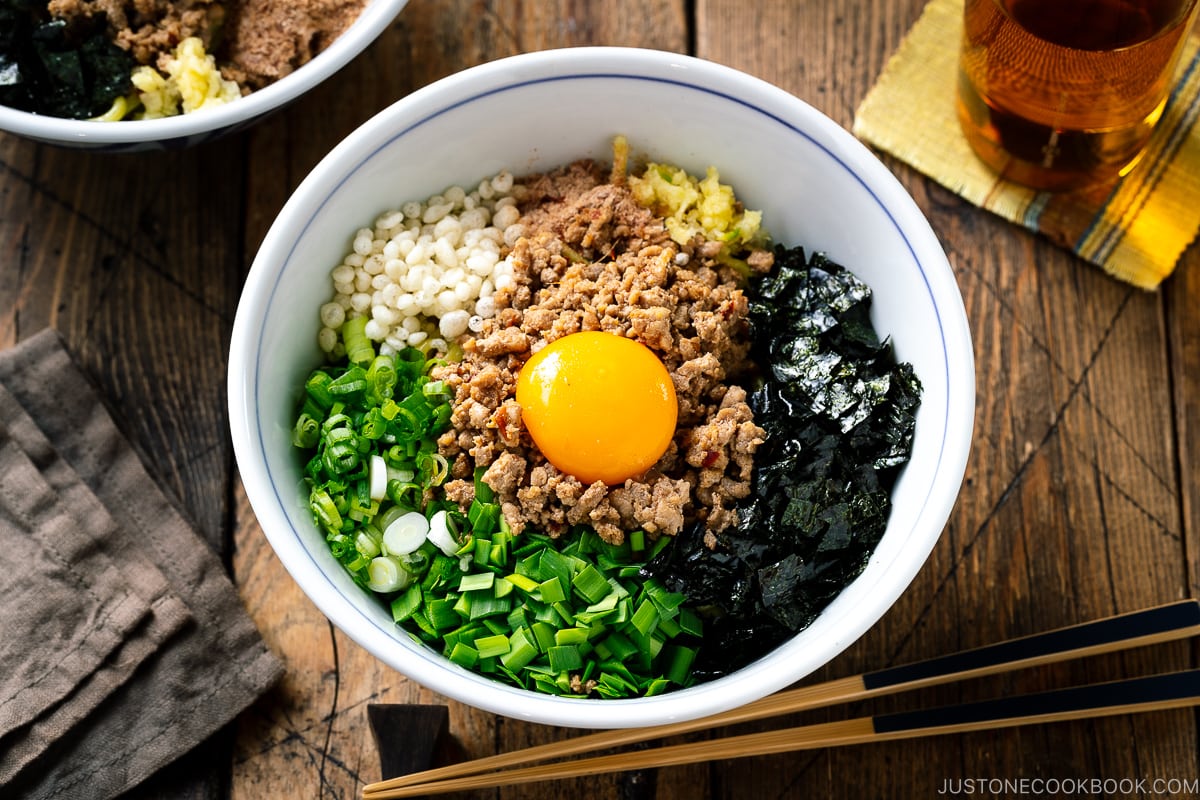
Wish to learn more about Japanese cooking? Sign up for our free newsletter to receive cooking tips & recipe updates! And stay in touch with me on Facebook, Pinterest, YouTube, and Instagram.
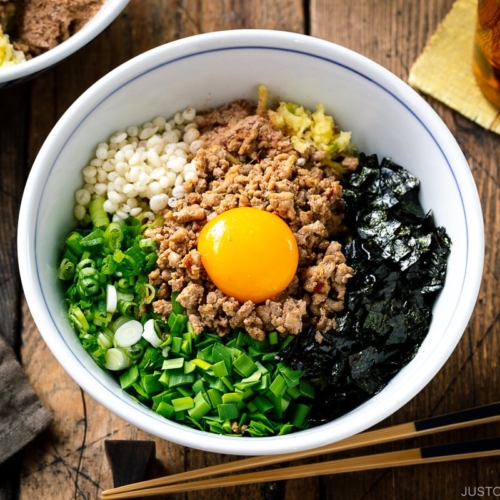
Mazesoba (Mazemen) – Japanese Brothless Ramen
Mazesoba, often called Mazemen here in the US, is Japanese soupless ramen that originated in Nagoya. The thick, chewy noodles are mixed with well-seasoned minced pork, garlic chives, green onion, nori seaweed, katsuobushi powder, and sous vide egg yolk. The creamy texture and savory flavorings make this a satisfying treat.
Ingredients
Instructions
-
Gather all the ingredients. Bring a large pot of water to a boil. Once boiling, turn off the heat and cover until you’re ready to cook the noodles. Prepare the toppings and seasoned pork while you’re waiting for the water to boil.
To Prepare the Seasoned Pork
To Assemble and Serve
-
First, put the seasoned pork with its cooking liquid on top and in the center of the noodles and create an indentation to hold an egg yolk. Next, place the green onions, garlic chives, katsuobushi powder, nori seaweed, crushed garlic, and tenkasu in small piles around the pork. Lastly, place the sous vide egg yolk in the indentation in the pork and serve warm. Mix the noodles and toppings with chopsticks until the egg yolk is well incorporated and enjoy.






More Stories
The Importance of Pricing Analysis
Movies About the Magic of Food – 4 Magical Movies for Halloween
2 Direct Mail Mistakes You Shouldn’t Make In Your Business